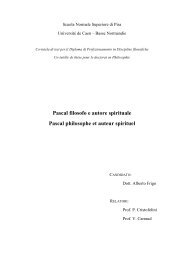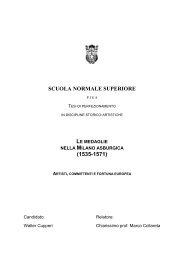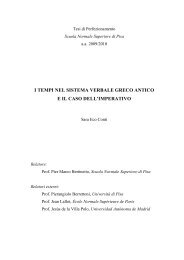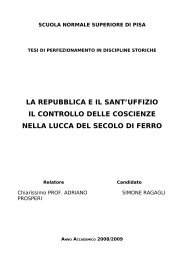CATULLUS 68 - Scuola Normale Superiore
CATULLUS 68 - Scuola Normale Superiore
CATULLUS 68 - Scuola Normale Superiore
You also want an ePaper? Increase the reach of your titles
YUMPU automatically turns print PDFs into web optimized ePapers that Google loves.
The apparatus criticus I should clarify how I have put together my apparatus criticus. Since I base my<br />
edition on O, G and R, I report all significant readings of these MSS, and omit negligible variants of spelling.<br />
I only quote the recentiores where they offer an attactive reading or one that is illuminating in some way.<br />
This is to say that I effectively treat the recentiores as sources of conjectures. I naturally try to attribute each<br />
such variant to the source(s) where it is first attested, with one condition: if a variant is attributed to only one<br />
MS in apparatu as well as in the commetary, that means that I could find it only in that one MS.<br />
Mynors used the Greek letters α – θ to refer to readings that derived from eight annotated manuscripts; he<br />
used α and β to refer to such a manuscript itself and γ – ζ to refer groups of manuscripts that descended from<br />
such a codex, while η and θ were used both for the parent MS (nos. 122 and 52, respectively) and for their<br />
descendants. This ingenious system of reference was conserved by Thomson, and I continue to use it here.<br />
With γ Mynors and Thomson meant ‘all the MSS of the γ class, or several’; I only use it to refer to all the<br />
MSS of that class.<br />
For the rest, I refer to the recentiores not by their name (e.g. Ricc. 606 or Riccardianus), but by an<br />
underlined numeral (e.g. 31), which is their number in the Table of Manuscripts in Thomson’s edition of<br />
1997. 176 I provide a list of the MSS in the Sigla (pp. 82-84).<br />
I have studied O, G and R and most or all of the recentiores conserved in Budapest, Florence, Oxford, Paris,<br />
Rome, Tübingen and Venice myself. For the other MSS quoted in my apparatus I used the Hale-Ullman<br />
Papers, a set of notes on the MSS of Catullus (including collations or transcriptions of 114 of them, as of<br />
2008) and on those of some other authors, that is conserved at the Department of Classics of the University<br />
of North Carolina in Chapel Hill. In general, I have been able to add little to Thomson’s excellent account of<br />
the principal MSS, especially of G and R, in his 1997 edition, but it has been possible to improve<br />
considerably on his account of the recentiores.<br />
When I started working on this volume, I intended to quote in the apparatus all conjectures that have ever<br />
been made. This turned out to be impracticable, as two groups of sources defied such a treatment. The<br />
codices recentiores are a valuable source of conjectures – in fact, a majority of those that I accept first appear<br />
there – but for every good reading they contain ten or twenty worthless ones. This, and the sheer number of<br />
recentiores that we have, means that one has to be selective in quoting them even in a detailed study such as<br />
this one. Almost equally intractable are the editions that were published between the middle of the 16 th and<br />
the middle of the 19 th century. Before Lachmann, editors were by and large unable to assess the value of<br />
manuscripts; they quoted them pell-mell and often gave undue weight to readings that have appeared since<br />
then to lack all authority. Some such readings, such as copia facta est in line 39, continued to be quoted and<br />
176 Thomson 1997: 72-91.<br />
79






